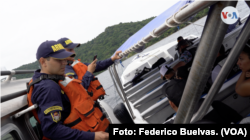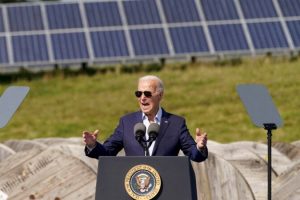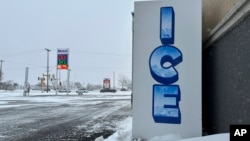The Chief of Staff of the Colombian Navy, Vice Admiral Orlando Enrique Grisales, said in an interview with the voice of americathat the Colombian island of San Andrés has become in the last year a corridor used by migrants who prefer to cross these waters in the Caribbean to reach Nicaragua, in order to avoid the dangerous journey through the Darién Gap.
Grisales assures that none of the boats that have left San Andrés with the migrants have the navigation regulations to go out into open water or high-frequency (HF) communication equipment to establish contact with land in case of shipwrecks.
In those waters, in December a boat with 24 migrants capsized between San Andrés and Isla Maíz in Nicaragua, and 20 of them are still missing.
Grisales also spoke about the Darién Gap, the dangerous jungle that connects Colombia with Panama and that thousands of migrants use to reach North America. Over there, drug trafficking groups force them to carry “10 to 20 kilos of cocaine” inside their belongings.
This interview has been edited for clarity and brevity.
Voice of America: Why are migrants taking the new route from San Andrés to Nicaragua?
Vice Admiral Orlando Enrique Grisales: Migration through San Andrés has increased. It is a little more expensive for the migrant, while for the Darién they could be paying between 2,500 and 3,000 dollars to reach the Gulf of Urabá and make the land transit and reach Panamanian territory to continue their journey. The tour of San Andrés, said by these same migrants, is 5,000 dollars.
Land transit from Panama and Costa Rica is spared, but we have had problems because here, unfortunately, due to the political relationship with Nicaragua, there is not the ease that there was with Panama and traffic is more difficult to control.
They pick them up at night, take them to one of the smaller keys, waiting for an also illegal boat to arrive to pick them up and transit them. There are 56 nautical miles that they have to navigate between San Andrés and the coast of Isla Maíz in Nicaragua. Many times these boats do not meet the standards for open water navigation, such as a minimum of two engines, redundant communication equipment, with VHF and HF to be able to have real-time communication in the event of a shipwreck.
VOA: How many of these illegal vessels have you intercepted?
Vice Admiral Grisales: In San Andrés we have captured 36 boats. Operations are permanent, sovereignty, care and protection not only of migrants, but also of legal activities, fishing, avoiding industrial fishing or fishing by other countries without permits in our waters, as it is permanent , but we have had 36 events where we have captured Colombian and Nicaraguan people, transporting them in boats that do not meet the standards and safety requirements for migrants to be taken to Nicaragua or to the border between Nicaragua and Honduras.
Today we have two boats, one from last year to which we learned from relatives of the people who boarded that boat who are asking for their relatives. We understand that that boat was wrecked and we have not heard from any survivors or someone who has reached the Central American coasts, understanding that the dynamics of the currents between San Andrés and Central America tend to take it by fleet to the Central American coasts. We have had no survivors.
At the beginning of this year in Costa Rica, the Costa Rican authorities reported the arrival of suitcases, suitcases and bags on the shores of shipwrecks of some of the boats that left illegally this month.
VOA: What are the migrants who enter the Darién forced to do?
Vice Admiral Grisales: It is a very difficult route that is also sometimes taken advantage of by other illegal groups, particularly drug traffickers, who force migrants to participate in the swarm of micro-trafficking by forcing them to carry 10, 15, and 20 kilos of cocaine inside their belongings to transport them. through the Darien Gap.
VOA: How do you work with the Panamanian authorities?
Vice Admiral Grisales: With the Panamanian authorities, last year the sea bridge was established, seeking to formalize the transport through the sea a little so that there are no boats leaving legally from Necoclí, often with overcrowds. So 80 people are mobilizing daily.
VOA: How have the operations carried out in the area of the Gulf of Urabá been?
Vice Admiral Grisales: In the Gulf of Urabá, we have the Urabá coast guard station. The Coast Guard station as a coast guard body of the National Navy is in charge of ensuring safety and compliance with safety regulations for life at sea. Also to maintain control in that area, which is used by criminal structures for cocaine hydrochloride trafficking, particularly that brought from the Colombian Caribbean coast, reaching the Gulf of Urabá and making maritime transit to start touching the Panamanian coasts.
VOA: What happened in 2022 with migrants through the Darién Gap? What is the balance?
Vice Admiral Grisales: In this area we rescued 228 migrants. That is why it is important to tell these people that although it is true it is slower, since we only have the capacity to move 80 people a day by agreement, that safe boat will arrive at port. The other vessels suddenly, because they did not wait their turn, may have news and since they leave without permits, they leave at night, as logically it is more difficult to carry out searches and rescues at night.
VOA: What is the call for migrants who pay and use these routes?
Vice Admiral Grisales: That they pay attention to the effort that the Colombian and Panamanian authorities are making to try to formalize this displacement of these migrants. The maritime bridge is established, 80 passengers per day, there are two boats that are leaving, one in the morning and the other in the afternoon, you leave from Necoclí and are arriving at La Miel (Panama). They leave a controlled port where the authorities are, where they do not have to pay any additional price for the ticket, they are arriving at a port where the authority is waiting for them, they are not being subjected to or may be subjected to robbery or recruitment by these structures to engage in illegal activity.
Connect with the Voice of America! Subscribe to our channel Youtube and activate notifications, or follow us on social networks: Facebook, Twitter and instagram the Voice of America.




![[Img #74662]](https://thelatestnews.world/wp-content/uploads/2024/12/Organisms-with-the-shortest-life-150x150.jpg)










